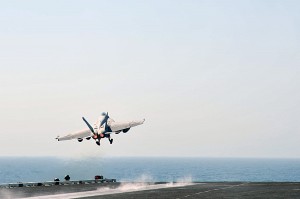2014-06-22 By Ed Timperlake
In 1966 the US Navy made a short movie about what was then called an “Attack Carrier.” The movie describes going to flight quarters and conducting combat air operations from an aircraft carrier off Vietnam. The political maneuvering by a President and Secretary of Defense who asked them to put their lives on the line was not discussed.
The US Navy when sent in harm’s way does whatever is asked to their last full measure, combat is their profession and loyalty to the Constitution not politics is their code.
“Ready on Arrival” highlights a simple truth evident today off Iraq that the direct lineage of the large deck aircraft carrier is an American point of pride. Engaging in combat almost fifty years ago and a modern carrier ready today personifies the fundamental point of the movie that the U.S. can with unexpected events put a Carrier on Station to support friends and confront enemies.
And so it goes fifty years later, off of Iraq.

The USS George H.W. Bush with escort ships the Destroyer USS Truxton, fresh from showing presence in the Black Sea, https://sldinfo.com/meeting-the-challenges-of-the-beaten-zone-at-sea-shaping-a-way-ahead/ , and the guided missile cruiser USS Philippine Sea are now on station.
Now the question is on station to do what?
Perhaps the “to do what” is captured in an interview with a Naval Aviator who was a Marine General on the ground in Iraq.
On December 9th 2009 USMC Brigadier General Walsh, USNA ’79, a Naval Aviator, discussed his recent experiences in Iraq with the Second line of Defense.
In December 2008 BG Walsh became the Commanding General of the 2ndMarine Aircraft Wing Forward and deployed to Operation Iraqi Freedom on November 3rd. One of his previous assignments was serving an instructor at the U.S. Navy Fighter Weapons School (Top Gun) and he is a decorated Marine Corps Aviator.
His words are noteworthy today:
For the Commanding Officer, the challenge is simply the following: “How does aviation provide support in such a chaotic environment? Just as the guy on the ground is not certain of what is about to happen, so does the pilot trying to support those ground elements: all must deal with managing uncertainty.”
As the Iraqi leadership began to perform more functions, there was a remaining need to reassure the population that support could be provided throughout the country to the Iraqi allies. “For example, when the provincial government was to be seated in Al Anbar in June 2009, there was an Al Qaeda threat to Ramadi. The Governor asked us to fly our F-18s at 5000 feet to reassure the population and to deter any threats.”
“I was on the ground; we were stopped at a check point and the check point came under motor fire. Several vehicles in front of us were destroyed. All hell was breaking loose with mortars coming in every few seconds. We did not know where the things were coming from. We of course had no battery radar. We called in some F-18s and the minute the planes showed up the firing stopped; the enemy figured out that the F18s would know where they were with the obvious consequences. How do you measure this effect?”
Notice Generals Walsh’s direct combat experience and his comments on the effective use of F/A-18s.
The Hornet is same aircraft on station today that makes up the combat strike package of the Bush.
If the “to do what” turns to combat an opportunity will not have been squandered.
In preparing for combat strikes, one of the most important opportunities, if possible, is to make combat ready but non-kinetic “fam” for familiarization flights in the air over any potential ground targets.
Air dominance over Iraq allows Navy combat pilots the luxury of becoming very familiar in their view from the cockpit with the terrain, the movement of the enemy, the location of “friendlies” and potential targets that they might be asked to attack.
Consequently, it is critical that the more Bush F/A-18 pilots gain eyes on experience over potential targets the better is the chance to mitigate collateral damage. If in doing so they get the attention of ISIS forces, as General Walsh experience shows all the better.
I suspect Special Forces also appreciates hearing what is often called in characterizing US Military Jet noise–“the sound of freedom”
USN/USMC aviation forces understand deeply their direct human responsibility when the pickle button or trigger is pulled–it is to first do no harm in accurately taking out some very bad people-that dimension of pilot in the cockpit CBG capability is critical and not well understood by non-aviators.
Ed Timperlake is a Carrier Qualified Naval Aviator who was CO of VMFA-321 a Marine Reserve Fighter Squadron and is a graduate of the 1969 class of the US Naval Academy.
See also:
For an opportunity to comment on this article, see the following:
http://www.sldforum.com/2014/06/ready-arrival-uss-bush-station-iraq-crisis/
And for a related article:
https://sldinfo.com/a-crucial-research-agenda-how-do-adversaries-view-us-use-of-military-power/

